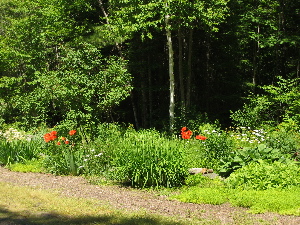A few years ago, we went to our first “Sugaring-Off party”. It was fun AND informational. We always get enough syrup to use as “house gifts” for our out of state friends. They all love it!
Anyway, we had never been to one of these, I thought there might be some of you out there in cyber-space that haven’t done this either. So, here’s the story of “Sugaring-Off” in the North Country.
We arrived at the “sugarin’ barn” that had steam and smoke POURING out of the metal stack at the top. If you didn’t know better, you’d think there was a fire burning out of control inside that fireplace. However, it was only steam, which is a by-product of the sugaring process, and smoke from the soft wood they use for firing up the burners under the syrup.
As we came in the little “ante-room” (I’m sure the farmer has another name for it…like “shed” or something equally original). There were pumps and tubes just everywhere, with the accompanying noises. This, we found out later on the tour, is where the syrup comes into the barn from the “sugarbush” (the stand of maples from which they take the syrup). They do not use buckets at this installation, as they tap about 8000 maple trees. That would be a bit of a job, wouldn’t you say? Anyway, there is a pump, which essentially vacuums the syrup into the barn. The maples are on a hill allowing gravity to play and important part in this whole process.
The next step was tasting the “Sugar on Snow”…a new experience for us both! They had a huge bucket of shaved ice, as nature was not being helpful. . It got up to 71 degrees the day before we went! Anyway, they had some maple syrup in a crock-pot that had been boiled down to a pretty thick consistency, just being kept warm. A spoonful of this thick syrup was ladled out on the snow in a very thin layer. It hardened immediately and we could just peel it off the snow and pop it into our mouths. Oh, my…ambrosia! It was the consistency of caramel with the flavor of rich maple syrup. Delicious and VERY sweet. They had a huge bowl of pickles made by the farm to which you could help your self. I had always wondered about the custom of serving pickles at a sugaring off party. Now I know why. The “Sugar on Snow” is SO rich and sweet, the pickle cuts through that sweetness allowing you to escape the incredibly sweet aftertaste you will be left with, sans pickle. I know, because on the way out, I stopped and popped a piece of maple sugar on snow into my mouth, not taking the pickle. I tasted that maple sugar all the way home (a 20 minute drive!) Donuts are also served. You can dip them in syrup or else there’s the Maple Spread, which is the consistency of Peanut Butter. A knife puts a big dollop on your donut, and your smile defines the moment.
Next step was where they displayed how the little plugs are attached to the trees trailing tubing throughout the “bush”. They drill a hole into the tree and insert the little blue, plastic plug. This plug is attached to the black tubing and you’re in business. Every year the plug is removed after sugaring season and the tree allowed to heal itself. I guess it forms a bit of a callus, and the section of the tree about one inch out from the center of the hole essentially dies. The new plug must be placed at least 5 inches from that wound next year, or it won’t work.
The black plastic tubing is a constant worry. All kinds of animals, even human, create problems with it. There are often holes found, put there by the teeth of everything from bobcats to foxes. Beavers sometimes build dams causing floods that freeze, stopping the flow! Another time, someone had burned the tubing, causing it to melt. And on and on. Anyway, if there’s a hole in the tube, the vacuum won’t work and the syrup squirts out. This means that the maze of tubing must be checked often.
Part of the tubing in the ante-room (or shed, if you’d prefer) is clear, allowing you to see the sap flowing through. It looked like water, with the same consistency. It takes 40 gallons of sap to make one gallon of syrup! Not much sap was flowing as we looked. It had been warm a few nights. In order to have good flow, the temperatures must drop below 32 degrees at night and climb above that temperature during the next day. If this doesn’t happen the sap does not flow up and down enough to be tapped. Eastern Canada and areas close to New England are the only areas of the world that produce Maple Syrup! I wasn’t aware of that, were you? The season lasts about 5-6 weeks from late February into early April. Some years are better than others, which is why some years the price of Maple Syrup is exorbitant.
Another thing I learned is that Grade B syrup is really much better than Grade A. It has much better flavor. Also the grading is for COLOR! Every day the grade will be different and it depends on the temperature of the environment. They have a hard time getting enough Grade B, which is what all their local (those “in the know”) customers want. In fact the farmer has his/her own “stock” that is called “Super B” that is used for cooking. So when you buy Maple Syrup, and have a choice, try Grade B.
They had 2 “evaporators” which do the boiling of the sap, creating the syrup. (The big joke in the North Country is that there are those who would like to make their own syrup, which is fine, but they do the boiling in their kitchen. The next day all the wallpaper is on the floor! (Remember the 40-1 gallon equation. There’s a LOT of steam generated by this process.) One of the evaporators essentially heats the sap for the next evaporator, which does the bulk of the work. They only use both evaporators when the sap is REALLY running. When we were here, only one was functioning.
In order to get the hot, quick fire they need to boil that sap, soft wood is used to burn. That’s wonderful, because no one else wants that wood for his or her fireplaces. So they get all the cast off wood from “blow-downs” and just junk wood to burn. People are happy to give them wood. Rarely do they need to actually buy it. Not a bad deal, eh?
The maple syrup is graded on the spot and bottled. Next step will be for us to buy it and pour it on our pancakes and waffles. I’m already looking forward to next year’s “Sugaring-Off” Party!
So, there you have it! New England may be gorgeous in the autumn, but the sheer delight of a “sugaring-off” party surely warrants a late winter visit here as well!
I hope you learned something new. I surely did!




